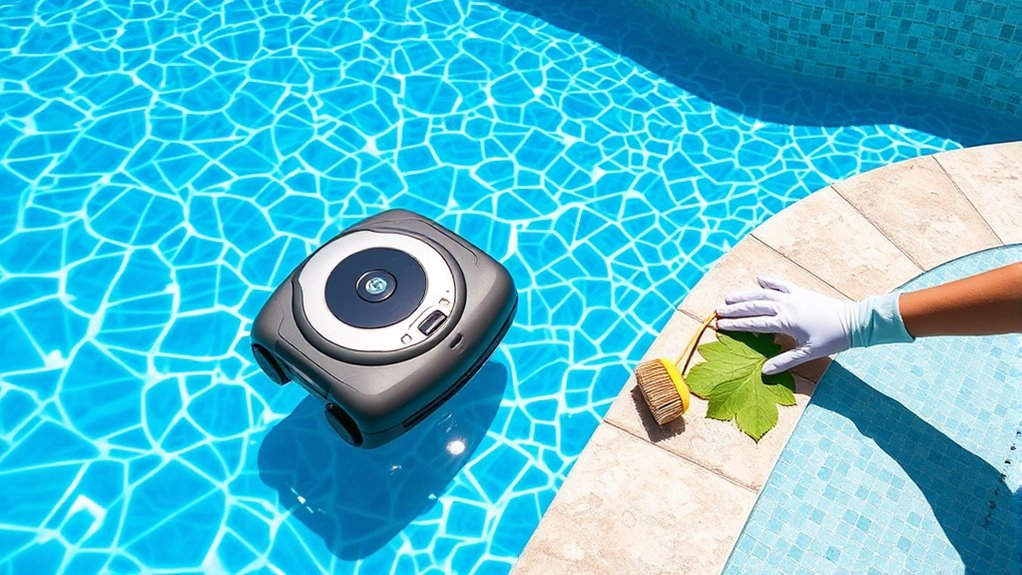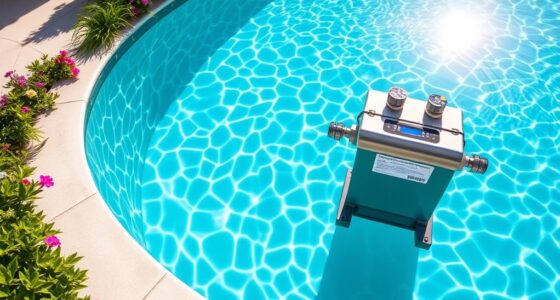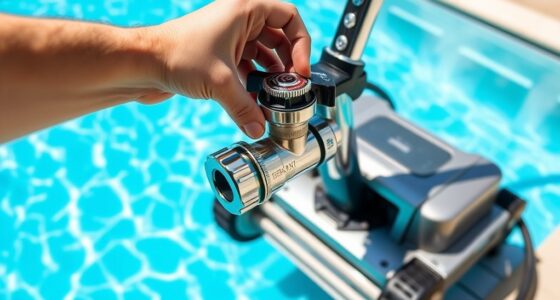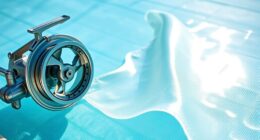Even if you rely on automatic pool cleaners, you still need to check and adjust your water’s chemical levels regularly to prevent damage and irritation. Cleaning and replacing filters ensures clear water and efficient operation. Skimming surface debris manually helps catch what machines might miss. Inspect your equipment for leaks or wear, and maintain water levels for peak performance. Doing these tasks regularly keeps your pool in top shape—keep going to learn more about staying on top of maintenance.
Key Takeaways
- Regularly check and balance water chemistry levels, including pH, chlorine, and alkalinity, to ensure water quality and safety.
- Clean or replace filter cartridges or grids periodically to maintain optimal filtration and water clarity.
- Remove surface debris manually with skimmer nets to complement automatic cleaners and prevent clogging.
- Inspect and maintain pool equipment such as pumps, heaters, and hoses to ensure reliable operation.
- Monitor water levels and perform routine testing for pH, alkalinity, and sanitizer levels to prevent damage and algae growth.
Regularly Checking and Adjusting Chemical Levels
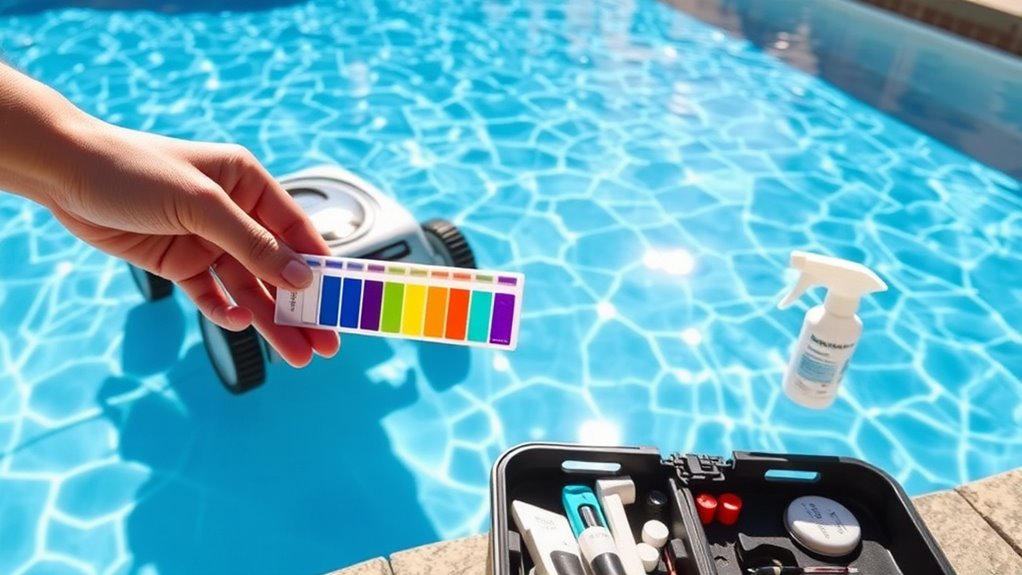
To keep your pool safe and inviting, you need to regularly check and adjust its chemical levels. Start with chemical testing to determine the current pH, chlorine, and alkalinity levels. Using a reliable water test kit or strips, quickly identify if any levels are off. If the pH is too low, the water becomes acidic, potentially damaging your pool and irritating swimmers. If it’s too high, disinfectants won’t work effectively. You’ll need to perform pH balancing by adding appropriate chemicals—like pH increasers or decreasers—to bring levels within the ideal range (7.2 to 7.6). Consistent testing and adjustments guarantee your pool water remains safe, clear, and comfortable. This simple routine helps prevent problems before they start, making pool maintenance easier overall. Regular testing of filtration systems ensures your equipment continues to operate efficiently and keeps your water clean. Additionally, monitoring your chemical levels regularly helps maintain optimal water quality and prevents long-term damage to your pool. Moreover, understanding how AI-powered monitoring systems can assist in maintaining water chemistry is an emerging trend in pool management. Staying informed about advanced filtration technologies can further improve your pool’s overall cleanliness and efficiency. Regularly inspecting your automatic cleaners can also help identify mechanical issues early, ensuring they operate effectively.
Cleaning and Replacing Pool Filters
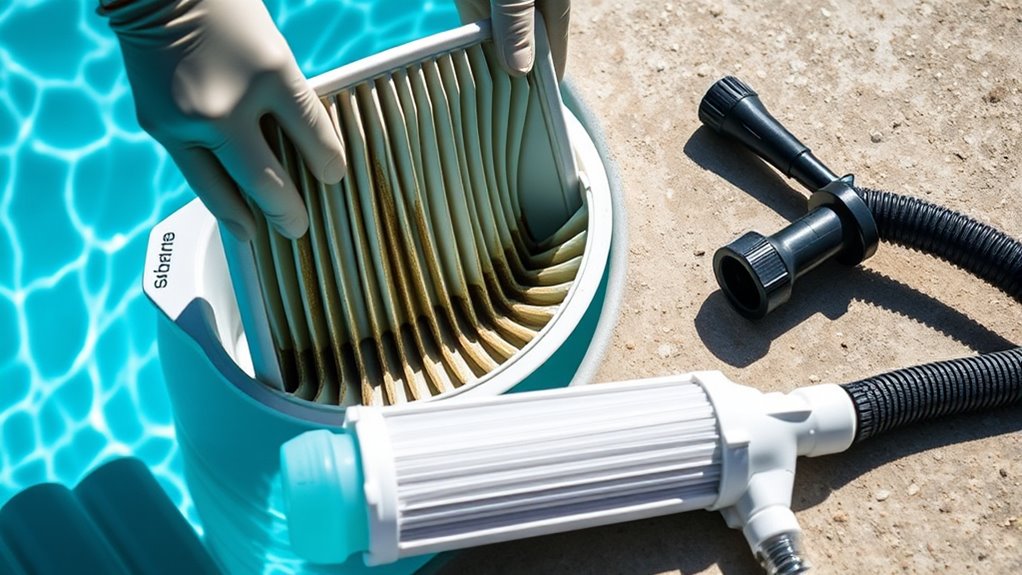
Regularly cleaning and replacing your pool filters is essential for maintaining clear, healthy water. Dirty filters hinder proper filtration, making your automatic cleaner less effective. To keep your system running smoothly, follow these steps:
- Remove the filter cartridge or DE grid, depending on your system.
- Perform filter cleaning procedures, such as rinsing with a hose or soaking in a filter cleaner solution.
- Inspect for tears or damage; replace if necessary.
- For pool filter replacement, install a new filter or grid, ensuring it’s seated correctly.
- Consider the benefits of electric pool maintenance tools, which can aid in more efficient cleaning and upkeep. Using advanced filtration systems can also improve water clarity and reduce overall maintenance needs.
Consistent filter maintenance prevents debris buildup and ensures ideal water flow. Regular filter cleaning procedures extend your filter’s lifespan, while timely pool filter replacement keeps your pool sparkling clean. Additionally, choosing proper filtration technology can further enhance water clarity and reduce maintenance frequency.
Skimming Debris and Removing Surface Leaves

Keeping your pool surface clean starts with skimming off debris and surface leaves promptly. Regular leaf removal prevents debris from sinking to the bottom and clogging your automatic cleaner. Use a skimmer net to quickly gather leaves, twigs, and floating debris, especially after storms or windy days. Effective debris clearance ensures your pool remains inviting and prevents algae buildup. Even with an automatic cleaner, manual skimming is essential for surface debris that the device may miss or struggle with. Focus on high-traffic areas and corners where leaves tend to gather. By maintaining a consistent skimming routine, you’ll reduce strain on your automatic cleaner and keep your pool looking pristine. Surface cleaning is a simple but crucial part of overall pool maintenance. Incorporating essential oils for surface cleaning can further enhance the cleanliness and freshness of your pool environment. Additionally, understanding the types of debris commonly found can help tailor your cleaning approach for better results. Regular inspection of your pool surface can also help identify potential issues early, preventing more significant problems later.
Inspecting and Maintaining Pool Equipment
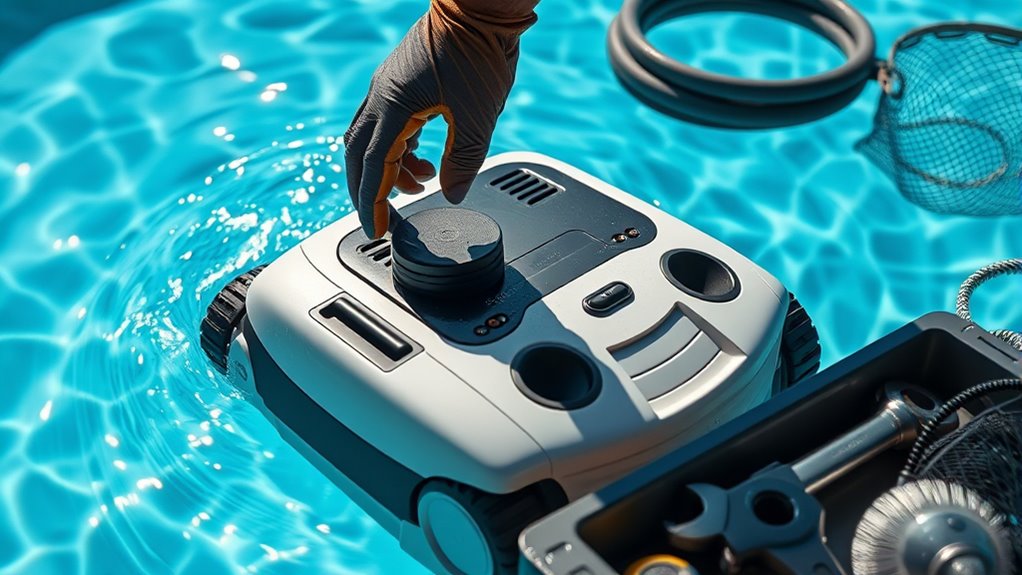
Inspecting and maintaining your pool equipment regularly is essential to guarantee everything functions properly and prevents costly repairs. Start by checking the pool heater for leaks, corrosion, or blocked vents to ensure efficient operation. Next, perform pump maintenance by inspecting the motor and impeller for debris or wear, which keeps your circulation system running smoothly. Also, examine hoses and fittings for leaks or cracks, replacing damaged parts promptly. Additionally, cleaning out skimmer baskets and pump strainer baskets to prevent clogging is crucial for optimal performance. Regularly testing your equipment helps catch potential issues early, extending its lifespan and maintaining water quality. Staying proactive with these tasks keeps your pool system reliable and efficient, making your swimming experience more enjoyable. Furthermore, understanding sound healing science techniques can help optimize your pool equipment’s performance and longevity.
Monitoring Water Levels and Addressing Water Balance
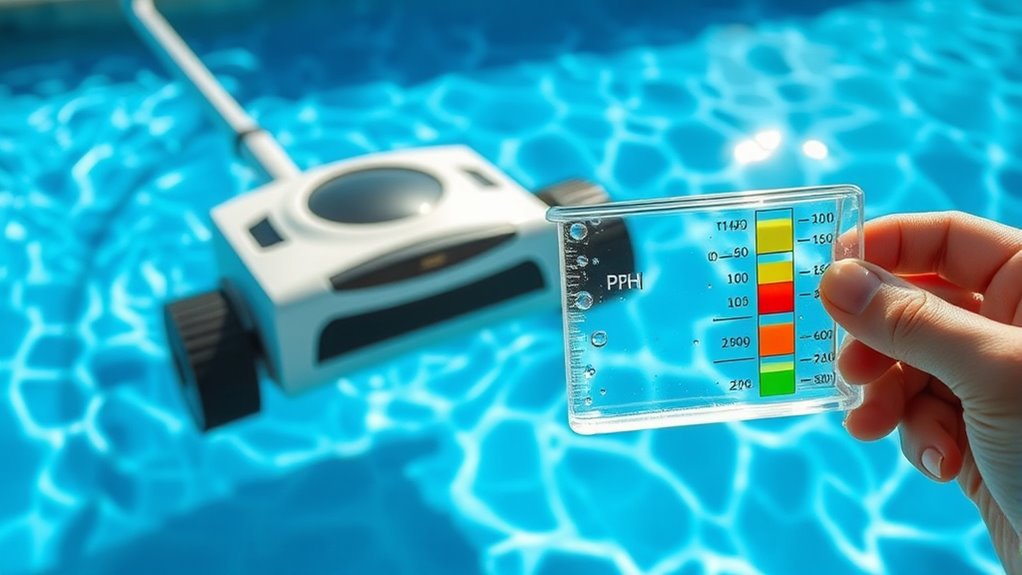
Monitoring your pool’s water levels is crucial because fluctuating levels can damage equipment and affect water quality. Proper water level management ensures the skimmer and pump operate efficiently, preventing issues like air leaks or pump damage. Regularly check the water level and add water when needed, especially after heavy usage or rain. Equally important is water chemistry control; balanced water prevents algae growth, corrosion, and cloudy water. Test your water frequently, adjusting pH, alkalinity, and sanitizer levels as necessary. Maintaining proper water balance also helps your automatic cleaner work effectively, as debris and dirt are less likely to stick or clog. Regular maintenance with AI-powered tools can further optimize water quality management. Additionally, understanding water testing methods can help you choose the most accurate and effective approaches for your pool. Proper knowledge of water parameters is essential for effective pool care. Consistent monitoring and adjustments, including understanding the vital water parameters, keep your pool safe, clean, and functioning effectively, reducing the need for costly repairs.
Frequently Asked Questions
How Often Should I Manually Vacuum My Pool?
You should manually vacuum your pool at least once a month to keep it clean, especially if you notice debris or cloudiness. Regular vacuuming helps maintain proper pool chemistry by removing dirt that automatic cleaners might miss. Also, it’s a good idea to vacuum before covering your pool for the season to reduce debris buildup. Consistent manual tasks guarantee your pool stays inviting and reduces the need for chemical adjustments.
What Safety Precautions Are Necessary During Manual Pool Maintenance?
During manual pool maintenance, safety is key. You should wear gloves and goggles to protect against chemicals and debris. Always turn off equipment before inspecting or cleaning it, and avoid mixing chemicals improperly. While balancing chemicals, handle them carefully and in well-ventilated areas. Regularly inspect your equipment for damage or wear, ensuring everything functions safely. These precautions help keep you safe while maintaining a clean, healthy pool.
How Can I Prevent Algae Growth With Manual Cleaning?
To prevent algae growth during manual cleaning, you need to focus on chemical balancing and algae prevention. Regularly test and adjust your pool’s pH, alkalinity, and chlorine levels to keep the water sanitized. Scrub surfaces thoroughly to remove algae spores and debris. Using algaecide as a preventive measure also helps, especially after heavy use or rain. Consistent maintenance and proper chemical balance are key to keeping your pool algae-free.
Are There Specific Tools Recommended for Manual Skimming?
Think of manual skimming as your trusty sifter in a vintage bakery, catching all the debris before it settles. You’ll want a fine mesh skimmer net, which is perfect for manual skimming and debris removal. Look for one with a sturdy handle for easy maneuvering. A telescopic pole can extend your reach, making it easier to clean the water’s surface efficiently and keep your pool sparkling clean.
How Do I Troubleshoot Issues With Automatic Pool Cleaners?
When troubleshooting automatic cleaner malfunctions, start by inspecting for clogs or debris that could block the device. Check hoses and filters during pool cleaner maintenance, as these are common issues. Confirm the cleaner’s wheels and brushes move freely. If problems persist, verify the power supply and connections. Regular maintenance can prevent many issues, keeping your automatic cleaner running smoothly and reducing the need for manual cleaning.
Conclusion
Even with automatic cleaners, some tasks like checking chemicals, cleaning filters, and skimming debris still need your attention. Don’t think you’ll be stuck doing everything manually—these tasks are quick and straightforward. Plus, staying on top of them keeps your pool sparkling and safe. So, embrace the routine; it’s a small effort for big results. Your pool will thank you with clear, inviting water whenever you’re ready to jump in!

